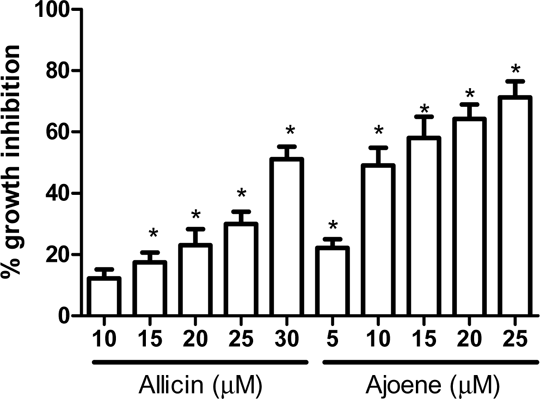Modulation of proliferation and tyrosine protein phosphorylation in HeLa cells by garlic derivatives INTRODUCTION: Garlic (Allium sativum, L.) has been considered as a remedy for the treatment and prevention of a number of diseases, including hypertension, headache, infection, and tumours. Therapeutic actions of garlic, although still discussed, have been attributed primarily to its organosulphuric compounds, but more detailed studies on chemically defined garlic components are needed to better clarify its pharmacological properties. In vitro and in vivo studies with garlic extracts containing alliinase have shown antiproliferative activity in several cell types. Alliinase acts on alliin to produce allicin, the precursor of several organosulphuric compounds including ajoene. Therefore, allicin and/or its metabolites may be responsible for the chemopreventive action of garlic. In the present study allicin and ajoene, two major components of garlic, were studied as inhibitors of HeLa cervical cancer cells proliferation. Further, the possible relation to protein phosphorylation in tyrosine residues has been explored. METHODS: HeLa cells, originated from human cervical cancer were maintained at 37°C, in a 95% humidified air containing 5% CO2. Cells were grown in T-75 tissue culture flasks with Dulbecco’s modified Eagle’s media (DMEM) supplemented with 15% of bovine foetal serum (FBS) and serially passed by trypsinization every 2-3 days. For proliferation studies, HeLa cells were seeded at 3×103 cells per well into 96-well plates and incubated with various concentrations of allicin and ajoene (5-30 μM) for 24, 48 and 72 h at 37°C. Cell viability was determined by a spectrophotometric method after staining alive cells with crystal violet. In order to study tyrosine phosphorylation, after stimulation with allicin or ajoene, cells were detached from culture flasks to carry out an inmunoprecipitation reaction with an anti-phosphotyrosine antibody coupled to protein A-agarose beads. Proteins were separated in a 10% gel by SDS-PAGE and then transferred to a PVDF membrane which was incubated for 2 h with anti-phosphotyrosine antibody (clone 4G10, Upstate Biotechnology, Lake Placid, NY). Phosphoproteins were visualized by enhaced chemiluminiscence using a goat anti-mouse antibody coupled to peroxidase. RESULTS: After 72 h of cell incubation maximum inhibition of cell growth were achieved. 30 µM of allicin or 10 µM of ajoene were the responsible concentrations to reduce about 50% HeLa cells proliferation. Tyrosine phosphorylation profile of HeLa proteins was also evaluated. Neither allicin nor ajoene changed the basal phosphorylation state of tyrosine-containing proteins in this type of cells. Nevertheless, both compounds prevented p42/44 (ERK) as well as p38-MAPK tyrosine phosphorylation enhaced by 1 U/ml thrombin, which could explain, at least in part, the antiproliferative effects of these derivates. CONCLUSION: Both garlic derivatives, allicin and ajoene were demonstrated to possess a remarkable antiproliferative effect on HeLa cells. This effect was irreversible as well as time and dose dependent. MAPK pathway was involved in the protective effect against thrombin induced phosphorylation. 
FIGURE 1 % of HeLa growth inhibition after a 72 h incubation period with the indicated concentrations of allicin and ajoene. Results are expressed as mean ± s.e.m. of five independent experiments. *P<0.01 versus the control, as determined by ANOVA/Dunnett´s.
|

